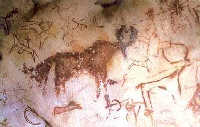| |
Rutog rock paintings
( 2005-10-17 )
 Rock art is also a kind of stone carving culture. During the early development of human society, people described and recorded their way of production and life through a simple and natural form -- stone inscription. This phenomenon became a precious cultural heritage left by ancestral people. Rock art is also a kind of stone carving culture. During the early development of human society, people described and recorded their way of production and life through a simple and natural form -- stone inscription. This phenomenon became a precious cultural heritage left by ancestral people.
In recent years, a large number ofrock paintingshave been discovered in Gerze, Ge'gyai and Rutog counties, which have a high elevation in the western and northern parts of Southwest China's Tibet Autonomous Region. These drawings are carved on stones with hard rocks or other hard objects, in both deep and shallow lines. There are also a few colorfully painted pictures.
The rock paintings cover a wide range of contents, including hunting, sacrificial rites, riding, domestic animal herding, and farming, as well as the sun and moon, mountains, cattle, horses, sheep, donkeys, antelopes, houses, and people.
Of these rock paintings, those discovered in Rutog County are the most outstanding. The rock paintings at a dozen places within Rutog, including Risum Rimodong and Lorinaka, are not only large in size and great in number, but are also of high artistic value.
Ngari was once the capital of the ancient Xiangxiong Kingdom. Xiangxiong writing was created by the ancestors of the Tibetan ethnic group and appeared before Tibetan writing. The rock paintings, which appeared in the same period as Xiangxiong scripts, are of great significance to studies on the history and culture as well as on early human life in Ngari and Tibet at large.
|
|

